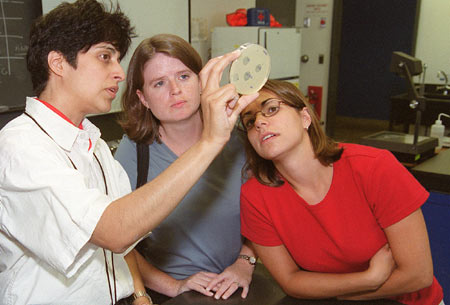The science of teaching science
High school teachers learn at Science Center

Last Thursday, on a day as beautiful as any this summer has offered, 14 Boston-area high school science teachers sat in the dark learning about mechanisms of cholesterol homeostasis. Later that day, they watched blood clot.
By all accounts, there was nowhere else the teachers would rather have been.
“It’s like a shot in the arm for a biology teacher to have a chance to do this,” said Stephen Spang, chairman of the science department at Wayland High School. “It’s really exhilarating.”
From July 9-13, Spang and his colleagues came to the Science Center to participate in a summer workshop for high school science teachers sponsored by Harvard’s Molecular and Cellular Biology (MCB) Department.
The workshop mixes cutting-edge science and practical classroom tools, a successful formula fine-tuned by Mandana Sassanfar, director of precollege science outreach for the department. Mornings are devoted to lectures by department faculty on their latest research. Afternoon labs, while they take advantage of high-end lab equipment and other impressive Harvard resources, are structured to give the teachers experience they can put to use in their classrooms.
“We are dealing with sophisticated concepts, but it’s also appropriate for our students,” said Dedham High School anatomy and chemistry teacher Kristen Long. “I’ve been to quite a few workshops, and this is one of the best.”
Stephen Harrison, Higgins Professor of Biochemistry and Molecular Biology, started the outreach program “about a decade ago” with money from a Howard Hughes Medical Institute grant. Originally targeted toward science teachers at Cambridge Rindge and Latin School, the program now welcomes advanced placement and honors biology teachers from schools around Boston, giving priority to teachers from Boston, Cambridge, and Somerville high schools.
“Working with teachers has proved to be the most effective way we can have impact,” Harrison said, crediting Sassanfar, who has run the program for five years, with its continued success. “We’re updating their knowledge base and giving them a feeling that they’re part of the international research community, and in turn they can excite their students.”
According to the teachers, Harrison’s vision is reality. The lectures introduce cutting-edge research and “give us a better big picture,” said Lydia Breen of Stoneham High School, who has attended the workshop for the past three years. Staying abreast of scientific developments that make headlines is important to her as a teacher, Breen said. Her students “love a connection to what’s happening on the news.”
Science, particularly biology, is moving so fast that “if you don’t pick up the latest in science, you’re going to have high schools that are 20 years out of date,” said Julie Snyder, a Cambridge Rindge and Latin teacher who has participated in the workshops since 1996. The more experience you have as a teacher, the farther you are from your own schooling and from fresh developments in your field, explained Snyder, who begins teaching at Hudson High School this fall.
Spending their lunch break swapping curriculum ideas and lab tips, the teachers ranked the program’s information sharing and collegiality as one of its major benefits. “I love being around people who are as excited as I am,” said Stoneham’s Lydia Breen. Teachers meet formally and network informally with each other throughout the year as part of the program. What’s more, their participation in the program gives them access to Harvard’s faculty and resources. “It’s easier to get, say, a bacterial culture,” said Julie Snyder. “They’re so generous with supplies when they have them.”
Indeed, during the blood coagulation lab Sassanfar offered Harvard facilities for future prep work. She also shared very nuts-and-bolts hints and resources to ensure that the lab would be friendly to high school students and bean-counting administrators. When teachers groaned at the high cost of the dog’s blood they were using, Sassanfar assured them they could cut costs by ordering blood from larger mammals such as cows or from rabbits, whose blood is cheaper because “they breed like rabbits,” she said. (All blood used is collected without harming the animals and is screened for pathogens.)
Throughout the lab, teachers buzzed with ideas on how they would modify the blood coagulation experiment to match their students’ needs. They could scale back the quantity to make the results appear faster, they said, and use a small beaker instead of a test tube for greater clarity. “I would absolutely use this in my classroom,” said Maggie Keeler of Lexington High School, who plans to tie in curriculum on clotting and hemophilia. “It’s a nice visual lab, which is great for the students,” said Lee Russo of Peabody.
The original grant that funded the program has run out, and the MCB department is now funding it fully. Neither teachers nor their schools pay to attend; in addition, teachers receive a stipend, laboratory kits, and materials for their classrooms, as well as that priceless Cambridge commodity – parking. Andy McMahon, Frank B. Baird Jr. Professor of Science and the department’s new chairman, is committed to continuing the program. “As a department and personally, we feel really strongly that the people who are educating the next generation should know about what’s going on at the scientific forefront,” he said.




